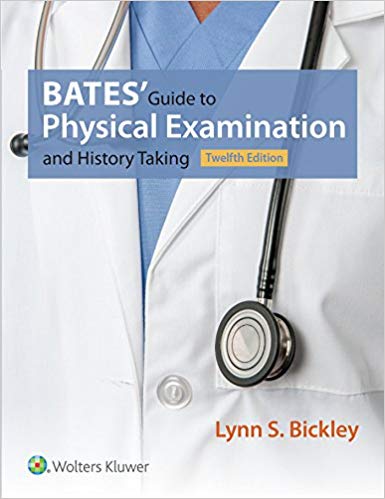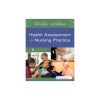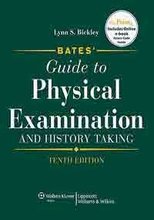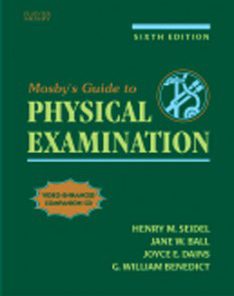Bates’ Guide to Physical Examination and History Taking 12th Bickley Test Bank
$35.00 Original price was: $35.00.$26.50Current price is: $26.50.
Bates’ Guide to Physical Examination and History Taking 12th Bickley Test Bank
Instant download Bates’ Guide to Physical Examination and History Taking 12th Bickley Test Bank pdf docx epub after payment.

Product details:
- ISBN-10 : 9781469893419
- ISBN-13 : 978-1469893419
- Author: Lynn S. Bickley
Bates’ Guide to Physical Examination and History Taking provides authoritative, step-by-step guidance on performing the patient interview and physical examination, applying clinical reasoning, shared decision-making, and other core assessment skills—all based on a firm understanding of clinical evidence.
Table of contents:
- Unit 1: Foundations of Health Assessment
- Chapter 1: Approach to the Clinical Encounter
- FOUNDATIONAL SKILLS ESSENTIAL TO THE CLINICAL ENCOUNTER
- APPROACH TO THE CLINICAL ENCOUNTER
- STRUCTURE AND SEQUENCE OF THE CLINICAL ENCOUNTER
- Stage 1: Initiating the Encounter
- Stage 2: Gathering Information
- Stage 3: Performing the Physical Examination
- Stage 4: Explaining and Planning
- Stage 5: Closing the Encounter
- DISPARITIES IN HEALTH CARE
- Social Determinants of Health
- Racism and Bias
- Cultural Humility
- OTHER MAJOR CONSIDERATIONS
- Spirituality
- Medical Ethics
- Documenting the Clinical Encounter
- REFERENCES
- Chapter 2: Interviewing, Communication, and Interpersonal Skills
- FUNDAMENTALS OF SKILLED INTERVIEWING
- Active or Attentive Listening
- Guided Questioning
- Empathic Responses
- Summarization
- Transitions
- Partnering
- Validation
- Empowering the Patient
- Reassurance
- APPROPRIATE VERBAL COMMUNICATION
- Use Understandable Language
- Use Nonstigmatizing Language
- APPROPRIATE NONVERBAL COMMUNICATION
- OTHER CONSIDERATIONS IN COMMUNICATION AND INTERPERSONAL SKILLS
- Broaching Sensitive Topics
- Informed Consent
- Working with a Medical Interpreter
- Advance Directives
- Disclosing Serious News
- Motivational Interviewing
- Interprofessional Communication
- CHALLENGING PATIENT SITUATIONS AND BEHAVIORS
- Patient Who Is Silent
- Patient Who Is Talkative
- Patient with Confusing Narrative
- Patient with Altered State or Cognition
- Patient with Emotional Lability
- Patient Who Is Angry or Aggressive
- Patient Who Is Flirtatious
- Patient Who Is Discriminatory
- Patient with Hearing Loss
- Patient with Low or Impaired Vision
- Patient with Limited Intelligence
- Patient Burdened by Personal Problems
- Patient Who Is Nonadherent
- Patient with Low Literacy
- Patient with Low Health Literacy
- Patient with Limited Language Proficiency
- Patient with Terminal Illness or Who Is Dying
- BEING PATIENT-CENTERED IN COMPUTERIZED CLINICAL SETTINGS
- LEARNING COMMUNICATION SKILLS FROM STANDARDIZED PATIENTS
- REFERENCES
- Chapter 3: Health History
- HEALTH HISTORY
- Different Kinds of Health Histories
- Determining the Scope of Your Patient Assessment: Comprehensive or Focused?
- Subjective versus Objective Data
- COMPREHENSIVE ADULT HEALTH HISTORY
- Initial Information
- Chief Complaint
- History of Present Illness
- Past Medical History
- Family History
- Personal and Social History
- Review of Systems
- RECORDING YOUR FINDINGS
- MODIFICATION OF THE CLINICAL INTERVIEW FOR VARIOUS CLINICAL SETTINGS
- Ambulatory Care Clinic
- Emergency Care
- Intensive Care Unit
- Nursing Home
- Home
- REFERENCES
- Chapter 4: Physical Examination
- ROLE OF THE PHYSICAL EXAMINATION IN THE ERA OF TECHNOLOGY
- DETERMINING SCOPE OF THE PHYSICAL EXAMINATION: COMPREHENSIVE OR FOCUSED?
- Comprehensive Adult Physical Examination
- HEAD-TO-TOE PHYSICAL EXAMINATION
- General Survey
- Vital Signs
- Skin
- Head, Eyes, Ears, Nose, Throat
- Neck
- Back
- Posterior Thorax and Lungs
- Breasts and Axillae
- Anterior Thorax and Lungs
- Cardiovascular System
- Abdomen
- Lower Extremities
- Nervous System
- Additional Examinations
- ADAPTING THE PHYSICAL EXAMINATION: SPECIFIC PATIENT CONDITIONS
- Patient on Bedrest
- Patient Using a Wheelchair
- Patient Who Is Postprocedure
- Patient Who Is Obese
- Patient in Pain
- Patient on Special Precautions
- RECORDING YOUR FINDINGS
- REFERENCES
- Chapter 5: Clinical Reasoning, Assessment, and Plan
- CLINICAL REASONING: PROCESS
- Basic Structure of the Clinical Reasoning Process
- Clinical Diagnostic Errors
- CLINICAL REASONING: DOCUMENTATION
- Document the Problem Representation (Summary Statement)
- Assessment and Plan
- RECORDING YOUR FINDINGS
- PROGRESS NOTE AND PATIENT PROBLEM LIST IN THE ELECTRONIC HEALTH RECORD
- Patient Problem List
- ORAL PRESENTATION
- REFERENCES
People also search:
Bates’ Guide to Physical Examination and History Taking 12th
Bates’ Guide to Physical Examination and History Taking 12th pdf
bates’ guide to physical examination and history taking questions
Bates’ Guide to Physical Examination and History Taking answer key
|
bates’ guide to physical examination and history taking questions
|
You may also like…
Test Bank
Test Bank for Bates Guide to Physical Examination and History Taking, 11th Edition : Bickley
Test Bank
Bates’ Guide to Physical Examination and History Taking 12th Edition Lynn S. Bickley Test bank












